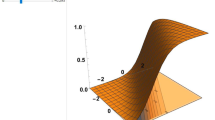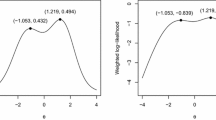Abstract
IRT-based models with a general ability and several specific ability dimensions are useful. Studies have looked at item response models where the general and specific ability dimensions form a hierarchical structure. It is also possible that the general and specific abilities directly underlie all test items. A multidimensional IRT model with such an additive structure is proposed under the Bayesian framework. Simulation studies were conducted to evaluate parameter recovery as well as model comparisons. A real data example is also provided. The results suggest that the proposed additive model offers a better way to represent the test situations not realized in existing models.
Similar content being viewed by others
References
Ackerman, T.A. (1993). Insuring the validity of the reported score scale by reporting multiple scores. Paper presented at the North American Meeting of the Psychometric Society, Berkeley, CA.
Aitkin, M. (1991). Posterior Bayes factors (with discussion). Journal of the Royal Statistical Society, Series B, 53, 111–142.
Albert, J.H. (1992). Bayesian estimation of normal ogive item response curves using Gibbs sampling. Journal of Educational Statistics, 17, 251–269.
Albert, J.H., & Chib, S. (1993). Bayesian analysis of binary and polychotomous response data. Journal of the American Statistical Association, 88, 669–679.
Béguin, A.A., & Glas, C.A.W. (2001). MCMC estimation and some model-fit analysis of multidimensional IRT models. Psychometrika, 66, 541–562.
Bradlow, E.T., Wainer, H., & Wang, X. (1999). A Bayesian random effects model for testlets. Psychometrika, 64, 153–168.
Box, G.E.P. (1976). Science and statistics. Journal of the American Statistical Association, 71, 791–799.
Carlin, B.P., & Chib, S. (1993). Bayesian model choice via Markov chain Monte Carlo. Research Report 93–006. University of Minnesota, Division of Biostatistics.
Carlin, B.P., & Louis, T.A. (2000). Bayes and empirical Bayes methods for data analysis. London: Chapman & Hall.
Chib, S. (1995). Marginal likelihood from the Gibbs output. Journal of the American Statistical Association, 90, 1313–1321.
Chib, S., & Jeliazkov, I. (2001). Marginal likelihood from the Metropolis-Hastings output. Journal of the American Statistical Association, 96, 1197–1208.
Gelman, A., Carlin, J.B., Stern, H.S., & Rubin, D.B. (2004). Bayesian data analysis. Boca Raton: Chapman & Hall/CRC.
Kass, R.E., & Raftery, A.E. (1995). Bayes factors. Journal of the American Statistical Association, 90, 773–795.
Lee, H. (1995). Markov chain Monte Carlo methods for estimating multidimensional ability in item response analysis. Ph.D. Dissertation, University of Missouri, Columbia, MO.
Meng, X.L., & Wong, W.H. (1996). Simulating ratios of normaliing constants via a simple identity: a theoretical exploration. Statistica Sinica, 6, 831–860.
Meng, X.L., & Schilling, S. (2002). Warp bridge sampling. Journal of Computational and Graphical Statistics, 11, 552–586.
Newton, M.A., & Raftery, A.E. (1994). Approximate Bayesian inference by the weighted likelihood bootstrap (with discussion). Journal of the Royal Statistical Society, Series B, 56, 3–48.
Osterlind, S. (1997). A national review of scholastic achievement in general education: How are we doing and why should we care? ASHE-ERIC Higher Education Report 25, No. 8. Washington, DC: The George Washington University, Graduate School of Education and Human Development.
Reckase, M.D. (1997). The past and future of multidimensional item response theory. Applied Psychological Measurement, 21, 25–36.
Ripley, B.D. (1987). Stochastic Simulation. New York: Wiley.
Robert, C.P. (2001). The Bayesian Choice (2nd ed). New York: Springer.
Schmid, J., & Leiman, J.M. (1957). The development of hierarchical factor solutions. Psychometrika, 22, 53–61.
Segall, D.O. (2001). General ability measurement: An application of multidimensional item response theory. Psychometrika, 66, 79–97.
Sheng, Y., & Wikle, C.K. (2007). Comparing multiunidimensional and unidimensional item response theory models. Educational & Psychological Measurement, 67, 899–919.
Sheng, Y., & Wikle, C.K. (2008). Bayesian multidimensional IRT models with a hierarchical structure. Educational & Psychological Measurement, 68, 413–430.
Sinharay, S., Johnson, M.S., and Stern, H.S. (2006). Posterior predictive assessment of item response theory models. Applied Psychological Measurement, 30, 298–321.
Sinharay, S., & Stern, H.S. (2003). Posterior predictive model checking in hierarchical models. Journal of Statistical Planning and Inference, 111, 209–221.
Spearman, C. (1904). General intelligence, objectively determined and measured. American journal of Psychology, 15, 201–293.
Spiegelhalter, D.J., Best, N., Carlin, B., & van der Linde, A. (2002). Bayesian measures of model complexity and fit (with discussion). Journal of the Royal Statistical Society, Series B, 64, 583–640.
Tanner, M.A., and W.H. Wong (1987). The calculation of posterior distribution by data augmentation (with discussion). Journal of the American Statistical Association, 82, 528–550.
Author information
Authors and Affiliations
Corresponding author
About this article
Cite this article
Sheng, Y., Wikle, C.K. Bayesian Irt Models Incorporating General and Specific Abilities. Behaviormetrika 36, 27–48 (2009). https://doi.org/10.2333/bhmk.36.27
Received:
Revised:
Published:
Issue Date:
DOI: https://doi.org/10.2333/bhmk.36.27




